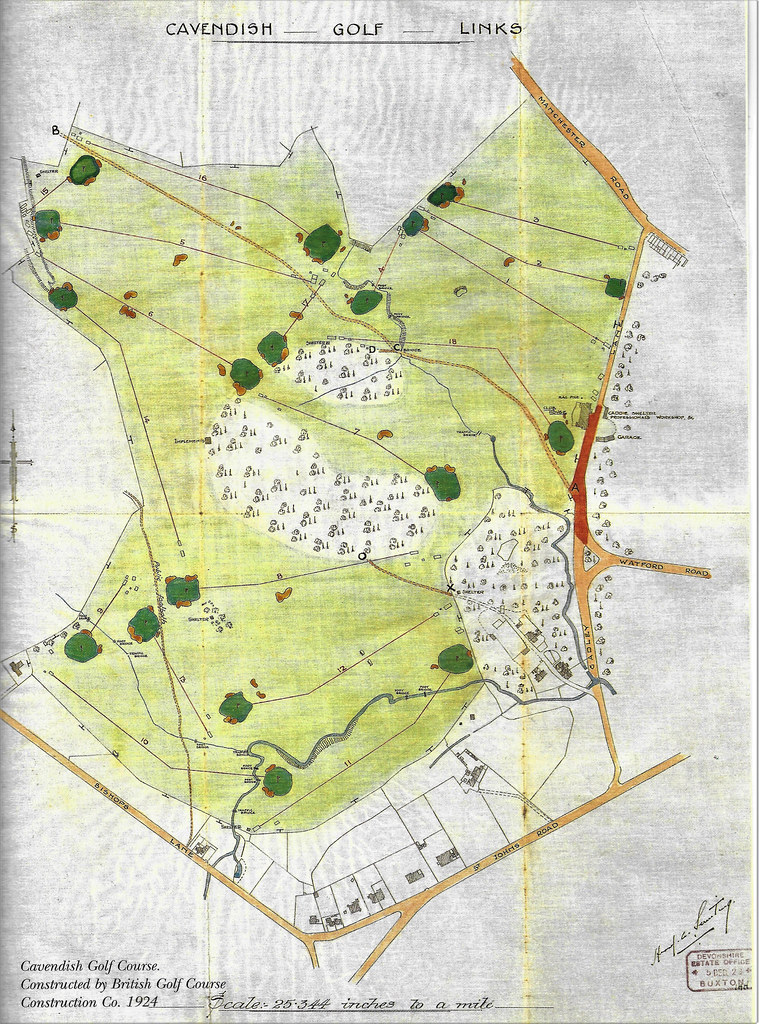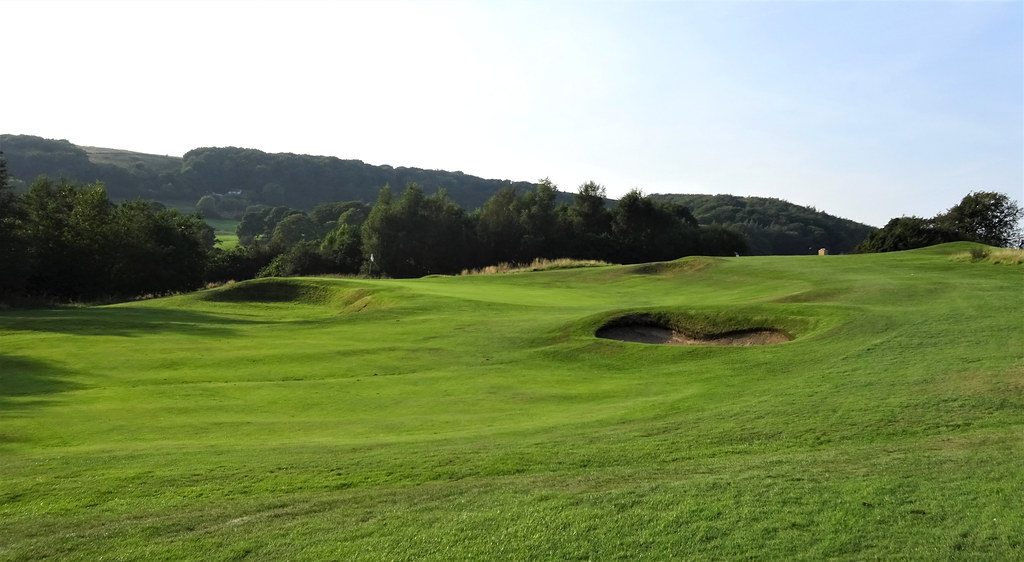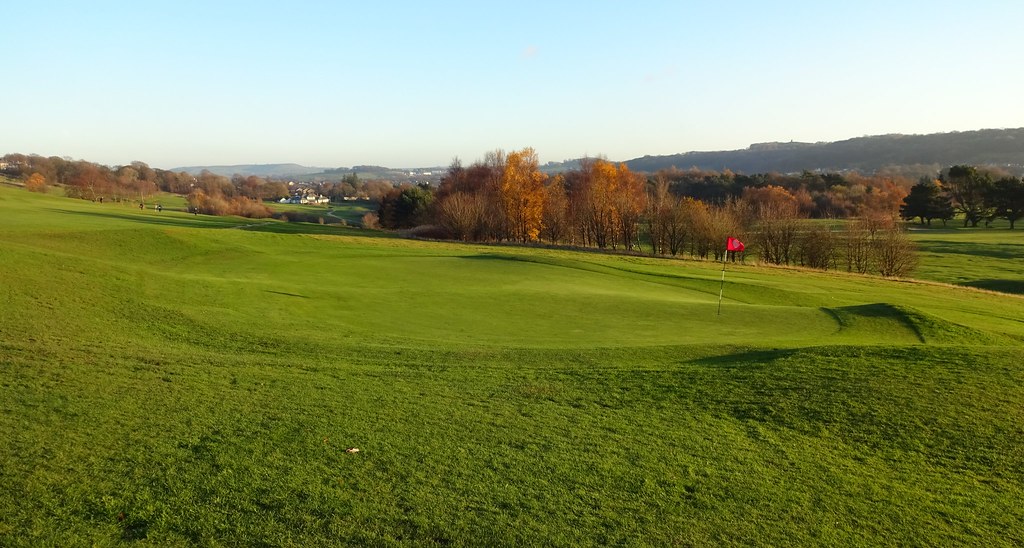Few courses have been born with the advantages of Cavendish GC. Not only did the 9
th Duke of Devonshire provide the land, he also paid for the construction of the course and the clubhouse! Furthermore, when the Duke terminated the lease for the Burbage Ladies GC, a pack of members became newly available to sign on to the new club. Finally, for many years the Duke’s estate subsidized the club until 1954 when the members purchased the club and adjacent farm for the criminally low price of £5000! Such largesse is to be roundly applauded.
The singular purpose of Cavendish's design is outstanding. The routing of the course is masterful with several clever changes of tempo and a flow which capitalizes on the terrain. It is surprising very few birdie opportunities exist when we consider the yardage from the back tees is just over 5700 yards. Most courses of this length would often be considered easy, but Cavendish has seven holes over 400 yards in length. Depending on wind conditions, all could take driver/wood to reach and a few will always require some wood play through the green. Mixed in with these longer holes are a handful of short par 4s, a few of which are reachable. Additionally, where Dr Mac makes up a ton of ground in creating a course which plays longer than 5700, is with the five par 3s, three of which are very short drop-shotters. I am personally not terribly keen on this sort of hole and playing three of them is certainly less than ideal, but in addition to the outstanding 13th which is decidedly an uphill one-shotter, they are critical transition holes which allowed Dr Mac to tackle some of the more challenging terrain without creating any uphill slog holes. I was especially impressed how Dr Mac got the most out of some of the prominent and not so prominent features. Three examples are:
1. Use of the stone wall on #14 creating a wonderful hole out of dead flat land.
2. The use of old railway embankment to house tees for #s 6 and 15 and create backdrops for #s 5 and 14 greens.
3. The River Wye is used for holes 10-12, #10 being one of the best holes on the course.
The course rests in a valley and as such there is some up and down. However, as mentioned above, Dr Mac cleverly avoided any arduous climbs, but Cavendish is a workout none the less. In addition to the terrain being wild and wooley at times, because of its position in the Peak District, the course receives a lot of rain and therefore the soil is heavy, moorland-like. That said, Cavendish could not be allowed to get too firm or some of the shots would be akin to playing pinball!
Map of the course.

The first three holes, 16 & 18 occupy most of the the roller coaster land - 1st green.

The 2nd turns back on the opening hole and climbs steadily uphill. Long drives offer a view of the tricky approach. #3 is a very good reachable par 4. The prominent centre-line bunkers are set well short of the green leaving an opening from the right. While the bunkers catch our eye, the real defence of this hole is its downhill nature carrying through the green. I note the club pushed the first cut of rough out on the right some 25 yards! This change may well result in tee shots being too far right for a decent angle of approach.

The fairway/light rough has recently been widened. The effect is to make these bunkers much more meaningful. Interestingly, the course map shows the bunkering hard on the green which would dramatically alter how the hole plays. The photo demonstrates how a drive can be worked wide right.

The first of three drop shot par 3s, the fourth recently had its strip bunker down the right removed. This bunker was not original as Dr Mac had two bunkers higher up the hill. After a four hole start which incredibly covers just over 1000 yards from the daily tees, the golfer is faced with one of the hardest holes on the course. This uphill 411 yarder plays closer to 450 yards. Due to a recent clearing, the hazard up the right can now be seen from the tee. The long approach to a raised green is similar to #14. Both of these greens are cleverly tied into the backing embankment.


Heading toward Horseshoe Plantation (a large wood in the middle of the course), the 6th features (rather pathetically) one of the few fairway bunkers on the course. It would seem that for the most part, Dr Mac's fairway bunker scheme is nowhere near intact. The green has two trees guarding either side. I know at least the concept of the tree on the left was original. Like the 2nd, the 6th green really comes alive in firmish conditions because despite appearances, the surface flows away from the fairway.
The seventh cuts the woodland in two with a reachable green, though it requires a very long and shaped drive to do so. The hole is rather awkward looking from the tee and creates doubt as to how far the carry is over the creek which loops around the fairway. The ideal layup point is some 200 yards off the tee. The 8th is one of my favourite holes due to a red herring. The tee shot is obscured and suggests a strong fade is the play. However, staying left leaves the best angle of approach even if it is a bit more dangerous on that side. Many greens at Cavendish offer Sunday hole locations tucked away behind bunkers. The far right bunker looks out of sorts, but the green swings all the way round to this corner.


The 9th is a bit of a let down because there are two other downhill short holes. The fronting bunker used to be hard against the green and look far more menacing. While the Raynor style flat bottom bunker is a more difficult hazard because of the steep face of the green pad, on a 130 yard drop shot par 3 with a pronounced tier I think the old bunker was visually much more effective. All that said, the green is of great interest!
While the front nine is solid golf with a few stand-out holes, the back nine is of a higher standard starting with the tenth. The player can take on the River Wye which plays diagonally across the fairway or play to the right, but not too far as oob lurks. If one plays to the right the chances of reaching the green are greatly reduced. One could also choose to lay-up, an option which takes oob out of the picture.

It isn't quite clear where the green starts and the fairway ends. The forward bunkers help to obscure the approach even the though player knows they are somewhere short of the green. The net effect is the player is more likely to take an extra club to avoid the trouble.

Like a few holes, the drive at #11 is obscured; enough so to mask the danger of hitting a driver. The approach crosses the River Wye again. Recent vegetation clearance along the river bank now allows for more choice of angles for the approach.

The 12th comes back on the 11th and is one of the least engaging holes on the course. Though it does have an interesting trio of raised cross bunkers cutting in from the right which block a clear view of the green. These can cause trouble if the flag is up front. Why? The green is heinously difficult to two putt from the rear!
#13 is an outstanding one-shotter which works around low ground shy of the green. What the player can't see very well from the tee is the relationship of the lone bunker to the green. There is just enough space to play between sand and green and hope for a bit of a kick left. The full frontal assault is a possibility made that much more enticing with the front bunker no longer in place. At one time there was a rear bunker, which may have guarded against the play over the green hoping for kick back.

It is often the case that I welcome flat holes mixed in with the more up and down golf. The difficulty with designing on flatter terrain near more rollicking land is that many golfers switch off and think of them as weak or breathers. A course such as Pyle and Kenfig is a case in point. There are a handful of very good holes on the relatively flat front side, yet many label them forgettable when compared to the back nine. The same might be said of Cavendish's 14th. From the tee the golfer is presented with a totally flat landscape bending around a stone wall - not terribly enticing. Upon walking 150 yards up the fairway the hole starts to reveal itself. The wall carries on left the full length of the hole and acts as a guide as to how far or near one wants to be from oob.

It is quite clear the hole is reachable if the player challenges the wall off the tee and for the second, but it may not be the sensible play. The small two tier green (nearly all of the greens on the course are smallish) is perched into the base of a ridge with bunkers protecting the flanks. The ridge somewhat disguises the fact that Dr Mac raised this green from a completely flat fairway. Dr Mac had two bunkers in that ridge for aesthetic effect, but also aided in guiding the approach. This may not be the best hole on the course, but it is a wonderful concept that demonstrates how pre-existing features can be used to full impact.

We now climb the ridge (an old railroad embankment) for the second time. The stellar 15th has a hint of the Eden about it. The pitch of the green pushes balls back down the hill toward the front bunkers. Any approach landing halfway up the slope of the green will do well to stay on the dance floor.


The cracking run of holes continues on the 16th, which is more reminiscent of #s 1-3. The severely downhill approach is a bit obscured unless one hits a very good drive. Although, the elevation drop into the green is a bit too severe if conditions get anything close to firm. There is a hump short left of the green which can be cruel or fruitful.


The only flatish par 3 on the course is a good one yet the elevation change uphill must be about a club despite appearances. Dr Mac once again uses fore bunkers to deceive and help suggest how a ground shot could be shaped. It is unclear if the left rear bunker is protecting this green or the 6th until we approach the green. The stunning finisher bends very hard right across a true elephant's graveyard. Perhaps 180 or so yards short of the green is a large dip; one wants to be either short or long, but never spot on in it. At about 430 yards the 18th is quite a challenge especially when one considers the wonky lies. The green is meant for an aerial approach and probably played more like a par 5 when the course was built in 1925.

It is plainly obvious I think Cavendish is a remarkable course. While some of the details such as lack of fairway bunkers, narrowing of fairways and green area reduction have compromised part of Dr Mac's original vision, the single biggest issue with Cavendish is its conditioning. The course usually plays a bit wet. Be that as it may, with at least nine excellent holes, three (#s 10, 13 & 15) of which are All England candidates, Cavendish is indeed special. Whereas many modern architects would have made Cavendish a longer, more testing course and likely a much tougher walk, Dr Mac kept the yardage very low, yet used the land brilliantly to make the course seem much harder than the scorecard would indicate. The casual visitor is most welcome and can play this Dr Mac gem for a very reasonable green fee. Can golf get any better than this for the price? Does golf need to be any better than this at any price? Without reservation, Cavendish merits a 1* in my book. 2021
See Cavendish GC: A Trip Through Time
www.golfclubatlas.com/forum/index.php/topic,67384.0.htmlCiao